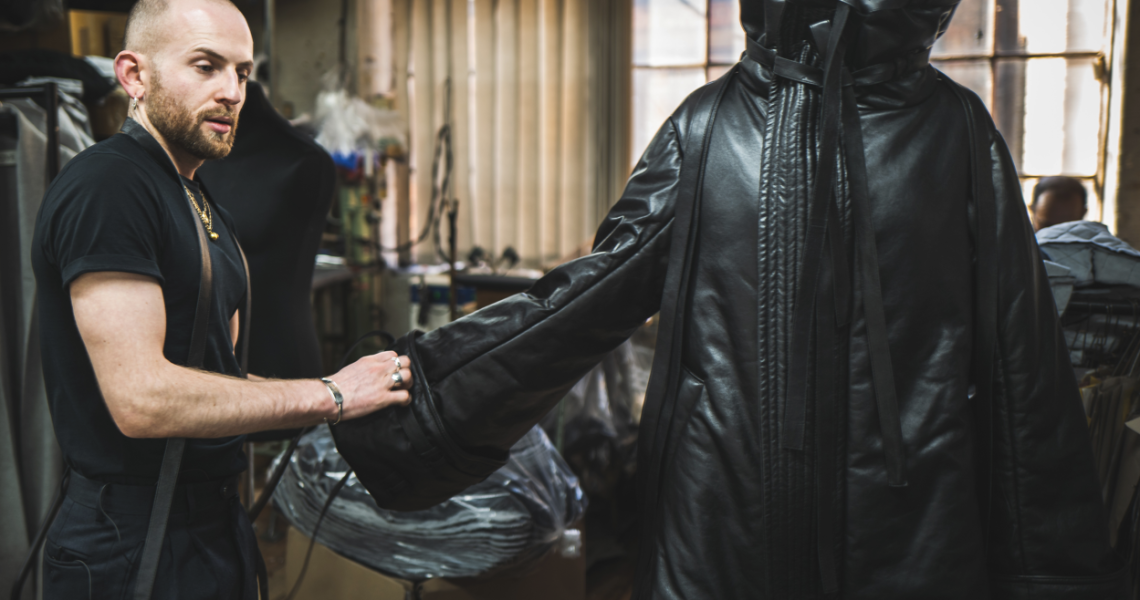To stay up-to-date on the latest runway shows, digital presentations and behind-the-scenes buzz, sign up to receive Glossy’s daily Fashion Month Briefing (February 10-March 7).
Amid the looming recession, brands are being strategic by prioritizing leather in their fall 2023 collections. At the same time, new, more sustainable approaches to producing the material are coming to light.
It is no surprise that, with brands increasingly feeling the effects of a troubled economy, leather is making a big comeback. So far at London Fashion Week, brands including Simone Rocha, Chet Lo and JW Anderson have debuted fall collections featuring a variety of leather bags, skirts and trousers. Historically, leather accessories and fashion pieces have together been luxury fashion’s biggest sales-driving category, with the highest margins.
However, leather production remains problematic, from an environmental perspective. Even mass market companies like VF Corp, which owns Timberland and The North Face, are working to clean up their leather supply chains. And, as runway looks inspire copies, the impact of leather pieces dominating runways will no doubt result in more plastic leather (PU) production and petrochemical use.
Among the biggest issues with current leather production is that leather isn’t recyclable, as the hides are typically finished with petrochemicals to create a plastic coating. According to research done by biotechnology company Evolved by Nature using Grandview and Flair insights, 150,000 metric tons of polyurethane are used for leather finishing globally every year.
“To meet higher degrees of performance and achieve a variety of different styles, leather has become reliant on fossil fuel-derived petrochemistry and synthetic polymers,” said Dr. Greg Altman, Evolved By Nature’s CEO and co-founder. “Those petrochemicals, plastics and forever chemicals find their way into the water, the air and our bodies.”
Fashion designers now play an important role in promoting and using new biotechnology concepts that alleviate petrochemical use. For his part, British designer Patrick McDowell has teamed up with the biotechnology company to debut its Activated Silk coating across four items in his fall 2023 collection: a bow handbag, a sports bag, a leather jacket and a leather puffer. The Activated Silk coating is made from natural silk protein, allowing leather items featuring it to biodegrade, assuming other compatible leather and production techniques are used by the brand. The four pieces will be introduced in Patrick McDowell’s fall show, dubbed “Cinderella Shall Go to the Football,” on Monday.
“Up until now, apart from briefly using other brands’ waste leather, we’ve completely avoided using it,” said McDowell, who has prioritized sustainability in his collections since his brand’s launch in 2018. ”Now, I want to uncomplicate the process and start turning things that can’t biodegrade into things that can.”
Evolved by Nature, which has previously partnered with Chanel, Anya Hindmarch and Jonathan Cohen, has received more than $220 million in funding. The company is currently exploring new uses for its proprietary silk technology across fashion and beauty.
The field of biotechnology offers many alternatives, beyond leather coatings, to traditionally used fashion materials. A 2020 World Business Council for Sustainable Development report projected that the global market for bio-based products will reach more than $7 trillion by 2030.
Other designers are leveraging biotechnology to create new fashion-forward materials.
Mata Durikovic, the Slovakian-born designer behind 1-year-old fashion MADbyMAD and an LVMH Green Trail Award nominee, is testing a bioplastic leather in her fall 2023 collection, shown on Sunday. On the catwalk, a bioplastic leather dress was cut and presented to front-row guests as something to eat, highlighting its safe composition. “Although leather in itself is a sustainable material, the problem now is that it is being mass-produced,” she said. “I like leather, but I don’t want to use it in my collection. Instead, I want to prove that sustainable alternatives can still achieve a similar luxury look.”
Luxury fashions made from leather alternatives remain difficult to price. In May 2022, Stella McCartney priced her Frayme bag, made from leather-alternative Mylo, at $2,490. Ganni’s Bou bag, launched earlier this month, is made of a leather alternative called Ohoskin that’s derived from cacti and orange waste. It retails for $511. Both Mylo and Ohoskin are scalable, allowing brands to retain the high margins of traditional leather styles.
The bioplastic used in Durikovic’s collection is a durable, transparent crystal material that can replace leather, when mixed with the right ratio of other ingredients. It also has the potential for inexpensive scalability — a key issue with alternative materials. As an LVMH Green Trail Award nominee, Durikovic is seeking investment in the technology, as she’s hoping to open a facility to produce it on a wider scale for luxury fashion use in the next two years.




